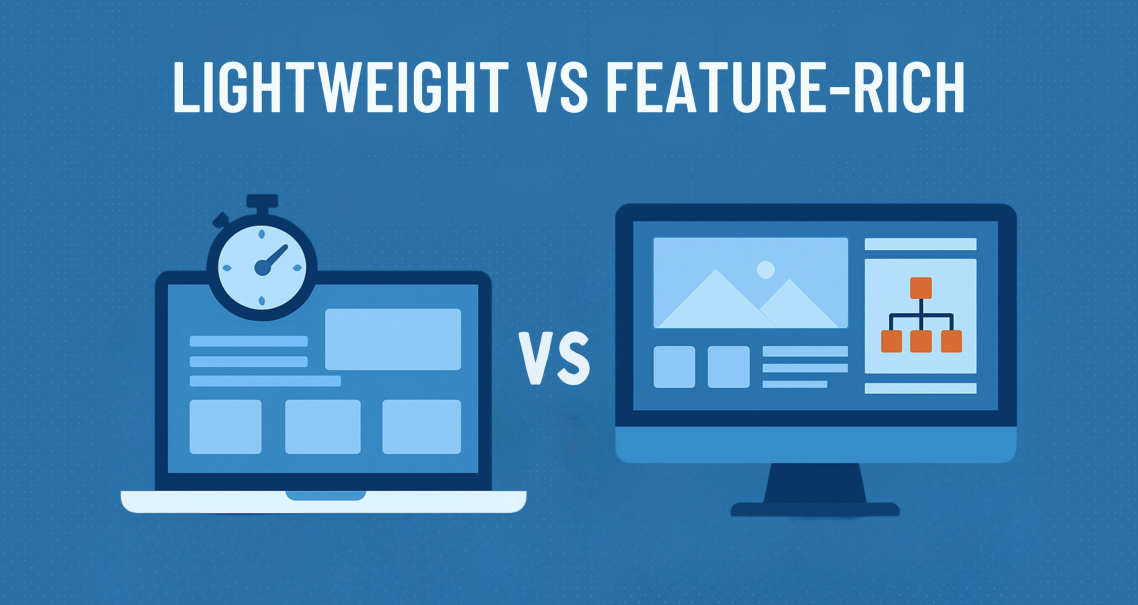
Lightweight vs Feature-Rich: Choosing the Right Theme and Page Builder for WordPress
When you launch a new WordPress site, one of the first decisions you face is how to design it. Do you pick a flexible page builder like Elementor or Beaver Builder, or do you start with a lean theme like GeneratePress and use Gutenberg, WordPress’s native block editor?
This choice matters more than many site owners realize. The theme or builder you choose affects how fast your site loads, how stable it feels, and how easy it is to maintain.
In this article, we’ll compare popular builders with lightweight themes, explore their impact on performance, and give you a decision framework to help you choose what fits your needs.
Why Page Builders Can Slow Down a Site
Page builders are popular because they make design simple. You can drag and drop elements without touching code. The trade-off is that they often produce a large Document Object Model (DOM), the structure a browser renders before showing a page.
The larger the DOM, the longer it takes to display content. This affects Largest Contentful Paint (LCP), the moment your main content becomes visible. It also increases memory use, which can be noticeable on mobile devices.
Builders also load extra CSS and JavaScript files. Even if you are not using certain widgets, the scripts may still run. This adds weight to each page, increasing Time to First Byte (TTFB) and slowing responsiveness.
Comparing Popular Page Builders
Here’s how some of the most common builders stack up:
Elementor
-
Strengths: Flexible, large ecosystem, easy for beginners.
-
Weaknesses: Can create heavy DOMs and requires optimization for good Core Web Vitals.
Divi
-
Strengths: Templates and visual editing.
-
Weaknesses: Among the heaviest builders, loads multiple CSS and JS files.
Beaver Builder
-
Strengths: Clean interface, stable over time, lighter than Divi or Elementor.
-
Weaknesses: Still heavier than Gutenberg, needs add-ons for advanced design.
Bricks Builder
-
Strengths: Advertised as lightweight, modern workflow, cleaner code than older builders.
-
Weaknesses: Still produces more DOM nodes than Gutenberg, performance depends on setup.
The bottom line: page builders offer flexibility, but speed comes at a cost.
Why Lightweight Themes and Gutenberg Shine
WordPress’s native block editor (Gutenberg) has matured into a strong option. It outputs leaner code and works well with full-site editing. For performance-focused projects, Gutenberg is a solid choice.
Combine it with a theme like GeneratePress or Kadence and you’ll get:
-
Minimal CSS and JS bloat
-
Faster LCP and lower Cumulative Layout Shift (CLS)
-
A small, efficient base with room to customize
For large projects or high-traffic sites, a custom theme may be the best choice. It removes unnecessary code and delivers exactly what you need for speed and scalability.
Real-World Performance Differences
Tests often show that lightweight setups load much faster:
-
A simple GeneratePress + Gutenberg site can load in under one second.
-
Elementor builds often need 2–3 seconds unless optimized.
-
Bricks performs better than Elementor but still needs careful configuration.
These differences are most visible on mobile devices, where slower CPUs struggle with heavy code.
Ease of Use: Where Builders Win
While performance matters, usability is important too. Builders allow non-technical users to edit pages with confidence.
-
Elementor’s drag-and-drop editing is easy to learn.
-
Agencies use templates to speed up delivery.
-
Clients can make changes without developer support.
For businesses where flexibility and editing speed matter more than a perfect performance score, a builder may be the smarter option.
A Simple Decision Framework
Here’s a guide to choosing the right path:
Choose a Page Builder if:
-
You need to launch quickly
-
Non-technical users will manage content
-
Design flexibility is a top priority
-
Performance is secondary to usability
Choose Gutenberg or a Custom Theme if:
-
Speed and Core Web Vitals are critical
-
You expect high traffic or run ecommerce
-
You want long-term scalability
-
You have access to developer skills
Think of it like this: a builder is a family car, versatile but not the fastest. A lightweight theme is a sports bike, fast and efficient but requiring more skill to handle.
Tips for Optimizing Builder-Based Sites
If you do stick with a builder, you can still keep performance under control:
-
Avoid deep nesting of elements
-
Deactivate unused widgets and modules
-
Use CSS utility classes instead of inline styles
-
Combine with a plugin like Perfmatters to control scripts
-
Enable server-level caching
These steps won’t make Elementor as fast as GeneratePress, but they can narrow the gap.
Conclusion
Choosing between a lightweight theme and a feature-rich builder isn’t about right or wrong. It’s about what matters most to your site.
If speed and scalability are the priority, Gutenberg with a minimal theme like GeneratePress or Kadence is the smarter choice. If ease of editing and design freedom matter more, a builder like Elementor or Beaver Builder may be worth it.
The best path is the one that fits your goals today and can grow with your site tomorrow. Test, measure, and adjust along the way, and you’ll end up with a WordPress setup that works for both your users and your business.



